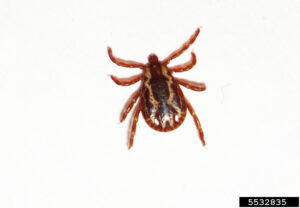 As the fall weather starts you might be tempted to put away your bugspray along with your shorts and flipflops but hold up! You still might need it. Some ticks may still be active well into the fall and even in the winter. These tiny animals are more than just a nuisance. They often carry a range of serious diseases that can have lifelong impacts on people, pets, and livestock.
As the fall weather starts you might be tempted to put away your bugspray along with your shorts and flipflops but hold up! You still might need it. Some ticks may still be active well into the fall and even in the winter. These tiny animals are more than just a nuisance. They often carry a range of serious diseases that can have lifelong impacts on people, pets, and livestock.
When are ticks active?
Many people assume that ticks go dormant once the weather starts to get colder. However, this is only partially true. Ticks, like most arthropods, do slow down once the temperature drops. However, many species of ticks will become active if the weather warms up again even if it’s only for a short period of time. A standard rule of thumb is that if the ground isn’t frozen and the temperature is above freezing, you should be worried about ticks.
Where are you most at risk for ticks?
Different ticks prefer different types of environments but are commonly found in wooded areas, leaf litter, tall grass, bushes, and woodpiles. They are less common in cut grass but are occasionally still found there.
What can you do to prevent ticks?
The old saying that an ounce of prevention is worth a pound of cure holds true with ticks. Many of the diseases that ticks can vector are still poorly understood and currently don’t have cures. It’s much better to take a few simple steps to avoid the risk of a tick bite than it is to deal with the consequences of one. Here are a few tips to prevent bites:
- Treat your clothes with a tick repellent like permethrin (ALWAYS read the label and follow the directions before using)
- Put on bugspray before you go outside
- Tuck in your shirt to limit tick access to your body
- Do a visual inspection of yourself and your clothes at the end of the day
- Use tape or a lint roller on your clothes after going outside to pick up any ticks you may have missed
These are just a few of the many ways you can prevent ticks bites. For more information, check out the resource list below!
What if I’m bitten by a tick?
There are a few steps you can take to prepare in case you are bitten by a tick. First, familiarize yourself with the types of ticks in your area and the symptoms of the diseases they carry. This is especially important if you work or recreate outside on a regular basis. Information on tick distribution is constantly being updated so we suggest checking the CDC website on ticks which also has tips on when to seek medical attention. Second, learn how to safely remove ticks and make sure you have removal tools on hand. Again, we defer to the CDC on the best ways to remove ticks safely.
Resources
- https://tickencounter.org/ticksmart/tips
- https://www.cdc.gov/ticks/geographic_distribution.html
- https://tickinsiders.org/
- A recent webinar on ticks
Cover image by Mohammed El Damir, Bugwood.org